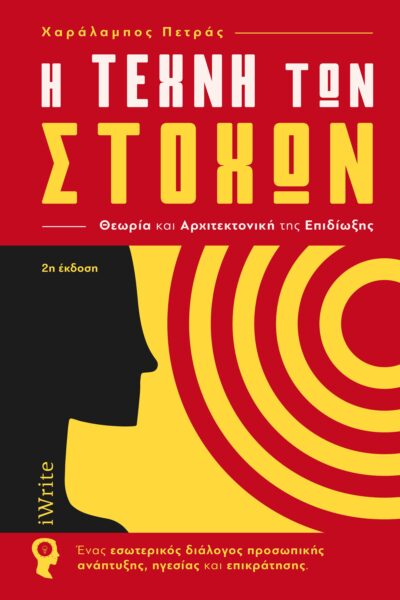Διαβάζουμε από το βιβλίο με μεθόδους coaching «Η Τέχνη των Στόχων», από τον Χαράλαμπο Πετρά.
Κάθε εμπόδιο φαίνεται ανυπέρβλητο αν ο στόχος δεν είναι πραγματικά σημαντικός.
Η συνειδητή αξιοποίηση εσωτερικών και εξωτερικών πόρων είναι αναγκαία για την υπέρβαση των εμποδίων που ανακύπτουν. Ο βαθμός δυσκολίας της διαχείρισης του εμποδίου ή, αλλιώς, πόσο ισχυρό θα θεωρηθεί, εξαρτάται από τις διαθέσιμες πηγές (γνώσεις, χρόνο, εμπειρία, κεφάλαιο, δίκτυο). Προσέξτε, όχι απλώς τις πηγές που υπάρχουν, αλλά εκείνες που έχουμε συγκεκριμένα διαθέσει στον στόχο. Επομένως, εάν ένας στόχος δεν είναι σημαντικός, και το παραμικρό εμπόδιο μπορεί να αξιολογηθεί ως ανυπέρβλητο δεδομένων των πόρων που διατίθενται. Κι αντιστρόφως, όσο πιο σημαντικός είναι ένας στόχος, τόσο που πιθανή είναι η υπέρβαση των εμποδίων, παρά το μέγεθος και τον συναισθηματικό τους αντίκτυπο.
Η επιδίωξη στόχων είναι μια άριστα σχεδιασμένη πορεία στο άγνωστο. Προχωρά από απρόβλεπτο σε απρόβλεπτο.
Ο σχεδιασμός περιλαμβάνει την προετοιμασία και προπαρασκευή για καθετί που μπορεί να προβλεφθεί. Δεν μπορεί όμως να συμπεριλάβει και να συνυπολογίσει το αδύνατο να προβλεφθεί με βάση την υπάρχουσα εμπειρία και γνώση. Για αυτό πρέπει να προσεγγίσουμε δημιουργικά τον σχεδιασμό ως μια διαδικασία προετοιμασίας για κάθε προβλέψιμο, ώστε να απελευθερωθεί χρόνος και ενέργεια για το απρόβλεπτο που οπωσδήποτε θα προκύψει. Στην πραγματικότητα, η επιδίωξη εξελίσσεται από απρόβλεπτο σε απρόβλεπτο.
Στις δυσκολίες χτίζεται ο χαρακτήρας, ιδιαίτερα σε αυτές που δεν θα μπορούσαν να προβλεφθούν.
Όπως αναλύεται και στο βιβλίο, σε ό,τι αφορά το coaching, η επιδίωξη αναπτυξιακών στόχων περιλαμβάνει καταστάσεις οριακές, στιγμές κρίσιμες, σταυροδρόμια σε γκρίζες ζώνες της αντίληψης. Εκεί που η πολυπλοκότητα δεν αφήνει περιθώρια για βεβαιότητες, ο χαρακτήρας θα κρίνει την έκβαση των πραγμάτων και ταυτόχρονα θα διαμορφωθεί. Επιλέγοντας πώς θα απαντήσουμε στη μεγάλη, αναπάντεχη ανατροπή, επιλέγουμε κι επιβεβαιώνουμε ποιοι είμαστε. Εκεί που η προετοιμασία δεν μπόρεσε να φθάσει, κτίζονται οι ταυτότητες, οι ομάδες, οι ηγεσίες και οι κουλτούρες. Για την καλύτερη αντιμετώπιση του απρόβλεπτου χρειάζεται συλλογή κι επεξεργασία όλων των δεδομένων, σοφή αξιοποίηση των προηγούμενων εμπειριών, διάθεση για αναθεώρηση, τεκμηριωμένες υποθέσεις (educated guesses), σύνεση και αποφασιστικότητα.
Οι στόχοι είναι οι μνήμες ενός μέλλοντος που αλλάζουν το παρόν.
Οι στόχοι μας αποθηκεύονται στη μνήμη μας. Στην πραγματικότητα, θυμόμαστε τι θέλουμε να επιτύχουμε, γιατί και πώς. Από τη στιγμή του καθορισμού τους, αποτελούν παρελθόν. Ως μνήμες πυροδοτούν πλάνα για το μέλλον, τα οποία με τη σειρά τους γίνονται κι αυτά μνήμες. Σε κάθε βήμα βρισκόμαστε σε ανοιχτό διάλογο με τη μνήμη μας. Αυτό σημαίνει δύο πράγματα. Πρώτο, ως παρελθοντικές συλλήψεις, οι στοχοθεσίες παραμένουν ζωντανές και υπόκεινται στη φυσική εξέλιξη της ζωής, αναθεωρούνται και εμπλουτίζονται. Δεύτερο, αν και θεωρητικά αφορά το μέλλον, η επίτευξη στόχων είναι κάτι που συμβαίνει στο εδώ και το τώρα. Η ίδια η επιδίωξη είναι ήδη μια αλλαγή στο παρόν.
Σε κάθε υψηλό στόχο προβάλουμε και έναν επιθυμητό εαυτό.
Αυτό που κάνει ελκυστικό έναν στόχο (μεταξύ άλλων σημαντικών στοιχείων) είναι η προβολή ενός επιθυμητού εαυτού στην επίτευξή του. Δηλαδή, η απάντηση στο ερώτημα «ποιος φαντασιώνομαι ότι θα έχω γίνει πετυχαίνοντάς τον». Ο εαυτός αυτός προβάλλεται ως δημιούργημα όχι μόνο της ίδιας της επίτευξης, αλλά και της πορείας. Μέσα σε κάθε υψηλό στόχο που αποδεχόμαστε, εκφράζεται μία πλευρά μας, τις ανάγκες και επιθυμίες της οποίας επιδιώκουμε να εκπληρώσουμε. Έτσι, συνδεόμαστε με τα σημαντικά και απαιτητικά.
Ψάχνεις βιβλίο σχετικά με τη μέθοδο coaching; Βρες το από τις Εκδόσεις iWrite

